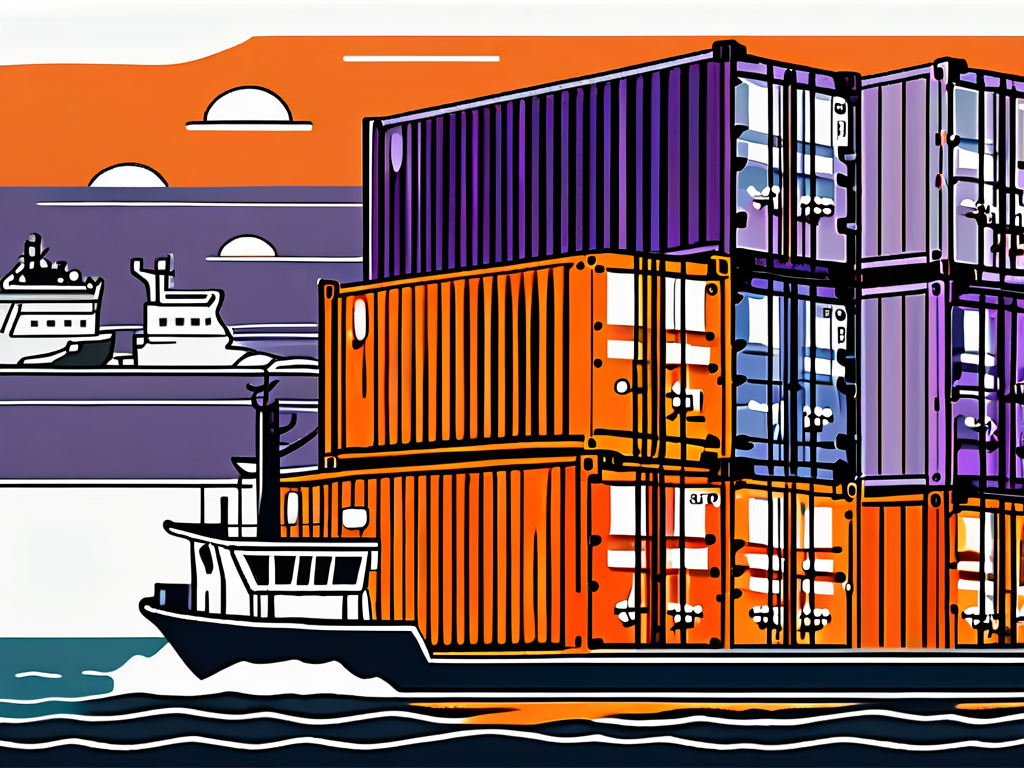Shipping containers provide a convenient and cost-effective way to transport goods across long distances. Whether you’re moving to a new country or need to ship goods for business purposes, it’s essential to understand the costs involved.
In this article, we’ll explore:
- The factors influencing shipping costs
- The different types and sizes of shipping containers,
- Various shipping methods
- Additional costs you should consider when shipping from Australia to the USA
Table of Contents
ToggleThe Breakdown of Shipping Costs from Australia to USA
While it can depend on a variety of factors, the cost of shipping a container to Australia from the USA typically ranges from $1,500 to $5,000 USD.
But again, it does vary significantly depending on the size of the container, the specific departure and arrival ports, and the shipping line.
Businesses looking to expand into the U.S. market can benefit from eCommerce fulfillment services for seamless international shipping.
Shipping costs are determined by several factors that are crucial to consider before making any arrangements. These factors influence the final price you’ll pay for transporting your shipping container. Let’s take a closer look at each of them:

When it comes to shipping costs, it’s essential to understand the intricacies involved in calculating the final price. Various elements come into play, each contributing to the overall expense of transporting goods from one location to another.
By delving deeper into these factors, you can gain a better grasp of how shipping costs are determined and how you can potentially optimize them to suit your needs.
Factors Influencing Shipping Costs
- Distance: The distance between the origin and destination plays a significant role in determining the shipping costs. The longer the distance, the higher the transportation expenses.
- Container Size: The size of the shipping container you choose will also impact the overall cost. Larger containers generally cost more to transport than smaller ones.
- Weight: Just like with any other shipment, the weight of your goods will affect the shipping costs. Heavier loads usually come with higher transportation fees.
Aside from distance, container size, and weight, other factors can influence shipping costs. These include the mode of transportation, such as sea freight or air freight, as well as any additional services required, like insurance or expedited delivery.
Understanding how each of these elements contributes to the final cost can help you make informed decisions when planning your shipments.
Average Shipping Rates
On average, shipping a standard 20-foot container from Australia to the USA can cost between $2,000 and $5,000. However, it’s important to keep in mind that these rates can vary based on the factors mentioned above, as well as other circumstances such as fuel prices and additional services required.
By exploring the average shipping rates for common routes, you can get a better sense of the baseline costs involved in international shipping.
This knowledge can serve as a valuable reference point when budgeting for your transportation needs and negotiating with shipping providers. Remember, staying informed about the various factors influencing shipping costs is key to managing expenses effectively and ensuring a smooth logistics operation.
Types of Shipping Containers
Shipping containers come in different types, each designed to accommodate specific cargo requirements. For specialty shipping, explore custom fulfillment services to ensure tailored shipping solutions.
Let’s explore the two main types:
Standard Shipping Containers
Standard shipping containers are the most commonly used type. They are available in two sizes: 20 feet and 40 feet. These containers are suitable for transporting general cargo, such as household goods and commercial products.
Standard shipping containers are constructed with durable steel frames to withstand the rigors of transportation by sea, land, and air. They are equipped with standardized fittings, allowing for easy stacking and securing during transit.
Additionally, these containers often feature wooden floors that can support heavy loads and forklifts for efficient loading and unloading operations.
Specialized Shipping Containers
Specialized shipping containers are designed for transporting goods that require specific conditions or handling. For example, refrigerated containers, known as “reefers,” are used for perishable items that need to be kept at controlled temperatures throughout the journey.
Open-top containers are used for bulky or oversized cargo that cannot fit through the standard container doors.
Refrigerated containers are equipped with advanced cooling systems that maintain precise temperature settings, ensuring the freshness and quality of sensitive cargo like fruits, vegetables, and pharmaceuticals.
On the other hand, open-top containers feature removable roofs or convertible tops, allowing for easy loading of goods that exceed the height limitations of standard containers. These specialized containers play a crucial role in the safe and efficient transportation of a wide range of goods across the globe.
Shipping Container Sizes and Costs
Shipping containers come in various sizes, allowing you to choose one that best fits your needs. Understanding the different sizes and their specific uses can help you make an informed decision when selecting a container for your shipping needs.

When it comes to small shipping containers, typically measuring 10 feet in length, they are perfect for individuals who need to ship a limited amount of goods.
These containers are more affordable compared to larger sizes and are often used for personal moves or small-scale commercial shipments. Their compact size makes them easy to transport and maneuver, especially in urban areas where space is limited.
Small Shipping Containers
A small shipping container, typically measuring 10 feet in length, is perfect for individuals who need to ship a limited amount of goods. These containers are more affordable and are often used for personal moves or small-scale commercial shipments.
Medium-sized shipping containers, usually 20 feet long, provide a balance between cost and capacity. They offer more space than small containers while still being manageable in terms of transportation and handling.
These containers are versatile and can handle a wide range of cargo, making them popular among individuals and businesses alike.
Medium Shipping Containers
Medium-sized shipping containers, usually 20 feet long, provide a balance between cost and capacity. They are versatile and can handle a wide range of cargo, making them popular among individuals and businesses alike.
Large shipping containers, commonly measuring 40 feet in length, are suitable for substantial cargo loads. Businesses often utilize these containers for bulk shipments or when moving large quantities of goods.
However, they come with higher transportation costs due to their size and weight. Despite the higher costs, the efficiency and convenience of being able to transport a large volume of goods in a single container can outweigh the expenses for many businesses.
Large Shipping Containers
Large shipping containers, commonly measuring 40 feet in length, are suitable for substantial cargo loads. Businesses often utilize these containers for bulk shipments or when moving large quantities of goods. However, they come with higher transportation costs due to their size and weight.
Shipping Methods and Their Costs
Once you’ve determined the type and size of the shipping container, the next step is choosing the most suitable shipping method. Two common options for shipping from Australia to the USA are:
Sea Freight Shipping
Sea freight shipping is the most cost-effective method for transporting goods over long distances. It involves loading the shipping container onto a cargo ship, which then travels by sea to the destination port. While sea freight is generally slower than air freight, it offers more affordable rates.
Sea freight shipping is a popular choice for businesses looking to transport large quantities of goods that are not time-sensitive.
It is also a more environmentally friendly option compared to air freight, as ships have a lower carbon footprint per ton of cargo transported. Additionally, sea freight allows for the transportation of oversized or heavy items that may not be suitable for air transport due to weight or size restrictions.
Air Freight Shipping
If you have time-sensitive or high-value goods, air freight shipping might be the best option. This method ensures faster delivery, but it comes at a higher cost compared to sea freight. Air freight is particularly suitable for perishable items or urgent shipments.
Air freight shipping is known for its reliability and speed, making it a preferred choice for businesses needing to meet tight deadlines. In addition to its quick delivery times, air freight offers better security measures for valuable or sensitive cargo.
Some airlines even provide temperature-controlled storage areas for goods that require specific climate conditions during transportation, such as pharmaceuticals or fresh produce.
For fast-moving goods, using subscription box fulfillment ensures reliable inventory turnover.
Additional Costs in Shipping
When calculating the overall cost of shipping a container from Australia to the USA, it’s crucial to consider additional expenses that might arise:
Insurance Costs
Insurance coverage is highly recommended when shipping goods internationally. It safeguards your cargo against loss, damage, or theft during transit. The cost of insurance will depend on the value of the goods being shipped and the level of coverage you choose.
Customs and Duties
When your shipment arrives in the USA, it will undergo customs clearance procedures. Depending on the type and value of the goods, you may incur customs duties, taxes, and fees. These charges vary based on the specific products being imported and the respective customs regulations.
It’s also important to consider the impact of fluctuating fuel prices on shipping costs. Fuel surcharges are common in the shipping industry and can significantly affect the overall cost of transporting goods. Keep an eye on fuel price trends and factor this into your budgeting to avoid any surprises.
Furthermore, the choice of shipping route can influence costs. Some routes may be more direct but come at a higher price, while others may take longer but offer cost savings. Evaluating different route options and their associated costs can help you optimize your shipping strategy and minimize expenses.
To simplify customs processes, work with retail fulfillment services for compliance-ready shipping.
Cost-Saving Strategies for Intercontinental Shipping
In conclusion, transporting shipping containers from Australia to the USA involves navigating a complex logistical landscape, where efficiency and cost-effectiveness are paramount.
By employing strategic cost-saving measures such as optimizing container space, choosing the right shipping partner, consolidating shipments, and staying informed about regulatory changes, businesses can significantly reduce expenses while ensuring timely and secure delivery of goods.
Need help with optimizing logistics? Fulfyld offers comprehensive 3PL fulfillment services to streamline your shipping operations and enhance efficiency.






